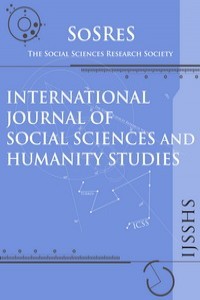TOWARDS HEALTHY ORGANISATION IN CORRECTIONAL SETTING: CORRECTIONAL OFFICERS’ WELLNESS, OCCUPATIONAL STRESS AND PERSONALITY
TOWARDS HEALTHY ORGANISATION IN CORRECTIONAL SETTING: CORRECTIONAL OFFICERS’ WELLNESS, OCCUPATIONAL STRESS AND PERSONALITY
correctional officers, wellness stress, personality,
___
- Booth-Kewley, S. and Vickers, R.R. (1994). Associations between major domains of personality and health behavior. Personality, 62(3), 281-298
- Brislin, R. (l970). Back translation for cross-cultural research. Cross Cultural Psychology: 1,185-216.
- Britton, D. (1997). Perceptions of the work environment among correctional officers: Do race and sex matter? Criminology, 35, 85–105.
- Callahan, L. (2004). Correctional officer attitudes toward inmates with mental disorders. International Journal of Forensic Mental Health, 3(1), 37-54
- Cavana, R.Y., Delahaye, B.L. and Sekaran, U (2001). Applied business research: quantitative and qualitative methods. Queensland, Australia: Wiley.
- Choi, P: Kavasery, R.; Desai, M.M.; Govindasamy, S.; Kamarulzaman, A. and Altice, F.L. (2010). Prevalence and correlates of community re-entry challenges faced by HIV infected male prisoners in Malaysia. International Journal of STD AIDS, 21(6), 416-423
- Conway, T.L.; Vickers Jr., R.R.; Wallston, K.A. and Costa Jr., P.T. (1992) Personality, health locus of control and health behavior. Paper presented at 1992 Annual Convention of the American Psychological Association, Washington D.C. August 14-18 1992.
- Costa, P.T.Jr. and McCrae, R.R. (1992). Revised NEO Personality inventory (NEO-PI-R) and NEO Five-Factor Inventory (NEO-FFI): Professional manual. Odessa, FL: PAR.
- Cullen, F.T.; Latessa, E,J.; Burton, V.S. Jr. and Lombardo, L.X.(1993). The correctional orientation of prison wardens: is the rehabilitative ideal supported? Criminology, 31, 69-92.
- Karasek, R., & Theorell, T. (1990). Healthy work: Stress, productivity, and the reconstruction of working life. New York : Basic Books
- Karofi, U.A. (2005). Drug abuse and criminal behavior in Penang, Malaysia: a multivariate analysis. Bangladesh e-Journal of Sociology. 2(2) July 2005, 1-12
- Kropp, P. R.; Cox, D. N.; Roesch, R. and Eaves, D. (1989). The perceptions of correctional officers toward mentally disordered offenders. International Journal of Law and Psychiatry, 12, 181-188.
- Mazlan, N.H.; Mat Saat, G. A and Ahmad, A. (2010). Identifying profile of female prisoners in Malaysia Prison using Carlson Psychological Survey. Malaysia Journal of Forensic Sciences,1(1),60-66
- McMillan, J. (2004). Defining interactivity. In: P. Rose, Editor, The Proceedings of the 2004 Conference of the American Academy of Advertising, American Academy of Advertising, 1.
- Myers, J.E., & Sweeney, T.J. (2004). The Indivisible Self: an evidence-based model of wellness. Individual Psychology: 60, 234-244.
- Nasir, R.; Zainah, A.Z., Khairudin, R.; Wan Shahrazad, W.S. and Latipun, S. (2011). Psychosocial factors between Malaysia and Indonesian juvenile delinquents. World Applied Sciences Journal, 12 (Special Issue of Social and Psychological Sciences for Human Development), 52-57
- Pfeffer, J. (2010). Building sustainable organizations: the human factor. Academy of Human Perspectives. February, 34-45 Purcell, J., Kinnie, N., Hutchinson, S., Rayton, B. and Swart, J. (2003) Understanding the People and Performance Link: Unlocking the Black Box. London: CIPD
- Senol-Durak, E., Durak, M. & Gencoz, T. (2006) Development of Work Stress Scale for correctional officers. Occupational Rehabilitation,16(1),157-168
- Suhr, D. (2006). Exploratory or confirmatory factor analysis? Proceedings of the Thirty-first Annual SAS Conference (SUGI 31), Paper 200-31.
- Sundt, J. L., & Cullen, F. T. (2002). The correctional ideology of prison chaplains a national survey. Criminal Justice, 30(5), 369.
- Yik, K.T (2006). Female Prisoners in Malaysia. Offender Rehabilitation, 43(1),45–64.
- Young, M. E. and Lambie, G. W. (2007). Wellness in schools and mental health systems: organizational influences. Humanistic Counseling, Education, and Development, 46, 98-113
- Başlangıç: 2009
- Yayıncı: Sosyal Bilimler Araştırmaları Derneği
THE EFFECTS OF KNOWLEDGE ECONOMY ON THE COSTS AND COST COMPARISON OF TRADITIONAL AND DIGITAL GOODS
DIFFERENT TYPES OF CAPITALS MOBILIZED TO STRENGTHEN LOCAL POLITICAL LEADERSHIP
QUALITY FUNCTION DEPLOYMENT AS A STRATEGIC PLANNING TOOL
Burcu DEVRİM İÇTENBAŞ, Hande ERYILMAZ
EUROPEAN-TURKISH IDENTITY INTERACTION FROM THE SOCIAL CONSTRUCTIVIST PERSPECTIVE
IMPACT OF THE CO-BRANDING ON CUSTOMERS’ LOYALTY IN STOCKMANN LTD
David Ferreira Lopes Santos, Santiago Valcacer Rodrigues
BOUNDARIES AND ETHNIC IDENTITIES THE CONCEPTION OF BOUNDARY IN A DIVERSE AREA
TRANSATLANTIC FREE TRADE AGREEMENT - STILL ALIVE OR DEAD CONCEPT IN EU-US RELATIONS?
THE NEED FOR CHARACTER EDUCATION
INNOVATIONS AND CHANGES BROUGHT BY THE LISBON TREATY: THE SOCIAL ASPECT
